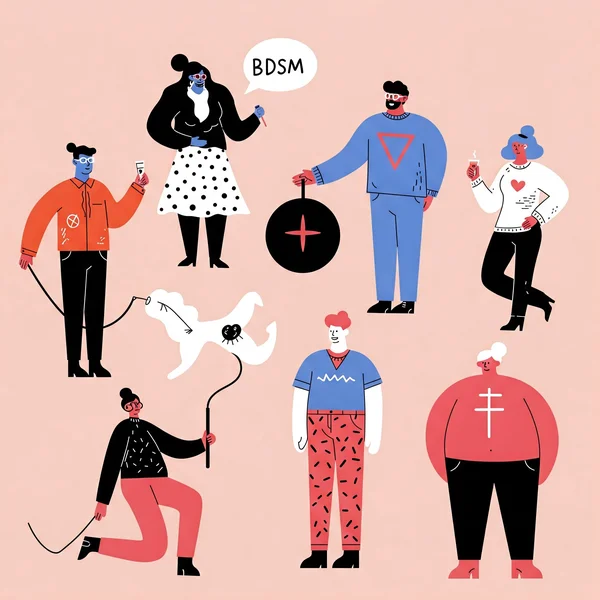BDSM Explained: Core Concepts Beyond Stereotypes
Demystifying BDSM: Understand Core Concepts & Consent Basics
BDSM. The acronym itself often conjures images fueled by sensational media portrayals – darkness, danger, maybe even something taboo. But behind the headlines and whispers lies a diverse world of consensual exploration, power dynamics, and unique expressions of sexuality and sensation. So, what is BDSM, really? If you're curious to look beyond the stereotypes and understand the bdsm basics, this article is your starting point. We'll break down the core concepts, emphasize the absolute necessity of consent, and debunk common myths, offering a clear and accurate bdsm definition. Ready to understand more? You can always explore related themes safely at KinkTest.net.
What Exactly is BDSM? Breaking Down the Acronym
What does bdsm stand for? BDSM isn't a single activity but an umbrella term encompassing a range of interests often grouped into three (sometimes overlapping) pairs:
Bondage & Discipline (B&D): Exploring Restraint and Rules
This component involves the consensual use of physical restraint (like ropes, cuffs, or ties) and the establishment of agreed-upon rules and consequences within a scene or dynamic. It can range from playful restriction to more elaborate scenarios, often focusing on trust, surrender, and psychological elements as much as physical binding.
Dominance & Submission (D/s): Understanding Power Dynamics
D/s explores the consensual exchange of power and control between partners. This involves establishing distinct roles where one person (the Dominant) takes a leading, authoritative role, and the other (the submissive) willingly yields control within agreed-upon limits. This authority exchange is deeply psychological and relies heavily on communication and trust, forming the core of many power dynamics within BDSM. Understanding these dynamics is a key part of the bdsm meaning.
Sadism & Masochism (S&M): The Role of Sensation Play
Often misunderstood, S&M in the context of BDSM refers to deriving pleasure from consensually giving (sadism) or receiving (masochism) physical or psychological stimulation that might include pain, intense sensation, or psychological "edge play." Crucially, this is about consensual pain and sensation play, where the experience is desired and controlled by all participants, vastly different from non-consensual acts. The goal is often heightened sensation, emotional release, or endorphin rushes within a safe framework.

The Non-Negotiable Foundation of BDSM
If there's one absolute, undeniable truth about ethical BDSM, it's this: consent bdsm is everything. Without enthusiastic, ongoing, and informed consent from all parties involved, an activity is not BDSM; it's abuse. This principle underpins every aspect of safe practice. How does bdsm work safely? It starts and ends with consent.
Safe, Sane, and Consensual Explained
The classic framework for bdsm safety is SSC:
- Safe: Practices should minimize the risk of serious or permanent physical or emotional harm. This involves understanding risks and using appropriate techniques and safety measures.
- Sane: All participants should be of sound mind, able to consent clearly, and understand the nature and potential consequences of the activities.
- Consensual: All activities must be freely and enthusiastically agreed upon by everyone involved, with the clear understanding that consent can be withdrawn at any time.
RACK and PRICK as Modern Frameworks
While SSC is foundational, the community often uses more nuanced frameworks today:
- RACK (Risk-Aware Consensual Kink): Acknowledges that not all BDSM activities are inherently "safe" in the conventional sense, but emphasizes understanding, acknowledging, and accepting the potential risks involved while still prioritizing informed consent. It's about being risk aware.
- PRICK (Personal Responsibility, Informed Consent, Communication, Kindness): Adds layers emphasizing individual accountability, thorough understanding before agreeing, continuous dialogue, and treating partners with respect and care. These frameworks highlight the importance of communication protocols.
Negotiation and Boundaries: Setting the Scene Before Play
Effective negotiation is vital before any BDSM activity occurs. This involves open discussion about desires, limits (hard limits that are never crossed, soft limits that might be negotiable), interests, fears, and expectations. Setting limits clearly ensures everyone feels respected and understands the parameters of the scene. This pre-scene talk is crucial for building trust.
Safe Words: The Essential Communication Tool During Play
Because BDSM can involve intense sensations or scenarios where verbalizing "no" might be part of the role-play (or physically difficult), safe words are essential communication tools. These are pre-agreed words or signals used to immediately stop or modify the activity. Common systems include:
-
"Red": Means stop immediately, everything ends.
-
"Yellow": Means slow down, check-in, intensity is nearing a limit.
-
(Green): Sometimes used to indicate "all good, continue." Using stop signals ensures control always ultimately rests with the person potentially receiving intense stimulation, reinforcing the principle of ongoing consent. Regular check-in practices are also encouraged.

Common BDSM Myths vs. Reality: Setting the Record Straight
Misconceptions about BDSM are widespread. Let's address some common bdsm stereotypes:
BDSM is Just Abuse or Non-Consensual
This is perhaps the most harmful myth. Is bdsm abuse? No. The defining difference is consent. Abuse is about power over someone without their permission; BDSM is about the consensual exchange or exploration of power and sensation. Consent vs abuse is the bright line differentiating ethical BDSM from harm. Any activity lacking enthusiastic consent falls outside the definition of BDSM.
It's Always About Extreme Pain
While S&M involves sensation, BDSM encompasses far more. Many activities involve minimal or no pain, focusing instead on psychological play, power exchange, bondage, discipline, or specific fetishes. There's a vast spectrum of intensity, from light bdsm to more intense experiences, tailored to individual preferences.
BDSM is Only for Certain "Types" of People
There's no single "type" of person who engages in BDSM. Participants come from all walks of life, genders, sexual orientations, relationship statuses, and backgrounds. The diversity in kink communities reflects the diversity of humanity itself. The bdsm community is incredibly varied.
It's Always Sexual in Nature
While BDSM often intertwines with sexuality, it doesn't have to be explicitly sexual. Some dynamics focus purely on power exchange, discipline, psychological elements, or achieving specific mental states, with little or no direct sexual contact involved. These non-sexual dynamics are a valid part of the BDSM landscape.

Exploring BDSM Interests: Where Does a Kink Test Fit In?
Understanding these bdsm basics might spark curiosity about your own interests. How do I know if I might like D/s? Or other aspects of BDSM? Self-reflection is key. Considering how you feel about power dynamics, specific sensations, or scenarios described here can offer clues.
Identifying Potential BDSM Leanings Through Self-Reflection
Reading accurate information (like this article!) and engaging in honest self-reflection can help you begin understanding desires related to BDSM. Do certain concepts resonate more than others? Do any of the debunked myths align with previous assumptions you held? This internal exploration is the first step.
Using Tools Like KinkTest.net as a Starting Point for Exploration
If you're curious about potentially exploring these bdsm leanings further, objective tools can be helpful. A comprehensive kink test like the one available on KinkTest.net serves as an excellent, private starting point. It's a kink assessment tool designed to help you identify potential areas of interest across the broader kink spectrum, including many elements relevant to BDSM, in a safe, anonymous environment.
Exploration is Personal and Always Optional
It's crucial to remember that this is a personal journey. Taking a test or learning about BDSM doesn't obligate you to act on anything. It's about gaining insight. Optional exploration, done safely and consensually if pursued, is the key. There should be no pressure to try anything that doesn't feel right for you.
BDSM Basics Demystified: Ready to Learn More Responsibly?

We've peeled back some layers, moving beyond stereotypes to understand the bdsm definition through its core components and, most importantly, the non-negotiable foundation of consent. BDSM, when practiced ethically, is a diverse realm built on communication, trust, and respect for boundaries. It's far more nuanced and varied than often portrayed.
Continuing to learn bdsm safely requires seeking out reputable information and prioritizing ethical practices. Remember, understanding is the first step towards responsible exploration, whether that exploration remains internal or eventually involves partnered activities.
Curious about where your interests might lie on the broader kink spectrum, including aspects of BDSM? Explore safely and anonymously with the Kink Test on KinkTest.net. It's a valuable tool for self-discovery.
Quick Answers for the Curious
Here are quick answers to some frequently asked questions:
-
Is BDSM legal if it's consensual?
Generally, yes, if it involves consenting adults and doesn't result in serious bodily harm that goes beyond what consent can legally cover (laws vary significantly by location, always be aware of local regulations). The key is demonstrable, enthusiastic consent. Activities that cross legal lines (e.g., involving minors, causing grievous injury beyond consented risk) are illegal regardless of purported consent.
-
Do you need expensive equipment to practice BDSM?
No. While specialized bdsm equipment exists, many BDSM activities require little to no equipment, focusing instead on psychological dynamics, simple restraints (like scarves), or using household items safely. Creativity and communication are more important than gear.
-
Can BDSM exist in a loving, healthy relationship?
Absolutely. For many couples, incorporating BDSM dynamics enhances intimacy, trust, and communication, strengthening their bond. Like any aspect of a relationship, healthy bdsm relationships thrive on mutual respect, open dialogue, and shared values, including enthusiastic consent.
-
How do I know if I might be interested in Dominance or submission (D/s)?
Reflect on how you feel about power dynamics in fantasy or reality. Do you enjoy taking charge or following instructions? Do scenarios involving control or surrender appeal to you? Answering questions on a confidential kink assessment like the one here can offer valuable clues and insights into potential d/s interest.
-
Where can I find reliable information to learn more about BDSM safely?
Seek out reputable BDSM educators, community organizations with clear ethical guidelines, established websites focused on consent and safety, and books by respected authors in the field. Always cross-reference information and prioritize resources that heavily emphasize consent bdsm and safe bdsm practices. Starting with foundational articles like this one is a good first step.